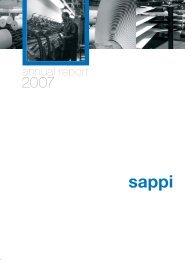2012 Integrated report - Sappi
2012 Integrated report - Sappi
2012 Integrated report - Sappi
Create successful ePaper yourself
Turn your PDF publications into a flip-book with our unique Google optimized e-Paper software.
9. Property, plant and equipment continued<br />
September 2011<br />
<strong>Sappi</strong> Fine Paper Europe<br />
Biberist Mill. In March 2011, <strong>Sappi</strong> announced the potential closure of its Biberist Mill in Switzerland. The mill ceased production<br />
during August 2011. The mill’s order book was transferred to the other <strong>Sappi</strong> European mills. An impairment charge of US$57 million<br />
was recorded against plant and equipment for that year. The remaining fixed assets, comprising land and buildings, were sold for<br />
US$56 million in fiscal <strong>2012</strong>.<br />
<strong>Sappi</strong> Southern Africa<br />
Usutu Mill. Usutu Mill ceased operations at the end of January 2010, and the pulp mill was permanently closed. The mill’s remaining<br />
property, plant and equipment which had already been substantially impaired in previous years, was fully impaired in fiscal 2011<br />
resulting in a charge of US$9 million being recorded in that fiscal year. <strong>Sappi</strong> continues its forestry operations in Swaziland.<br />
Adamas Mill. In May 2011, we announced the potential closure of Adamas Mill. The mill was closed in August 2011 and the more<br />
profitable grades were transferred to Enstra Mill and Stanger Mill. The plant and equipment other than land and buildings was impaired<br />
by US$10 million. The land and buildings were sold for US$5 million in fiscal <strong>2012</strong>.<br />
<strong>Sappi</strong> Paper and Paper Packaging Operations. A review of the paper and paper packaging operations completed in the fourth fiscal<br />
quarter of 2011, indicated that the production of certain paper and paper packaging products would have to be curtailed. The curtailment<br />
of the production of these products resulted in an impairment charge of US$49 million being recorded in that year.<br />
US$ million <strong>2012</strong> 2011<br />
10. Plantations<br />
Fair value of plantations at beginning of year 580 687<br />
Gains arising from growth 83 81<br />
Fire, hazardous weather and other damages (4) –<br />
Loss arising from fair value price changes (15) (16)<br />
Harvesting – agriculture produce (fellings) (73) (82)<br />
Disposals (1) –<br />
Translation difference (15) (90)<br />
Fair value of plantations at end of year 555 580<br />
<strong>Sappi</strong> manages the establishment, maintenance and harvesting of its plantations on a compartmentalised basis. These plantations are<br />
comprised of pulpwood and sawlogs and are managed in such a way so as to ensure that the optimum fibre balance is supplied to its<br />
paper and pulping operations in Southern Africa.<br />
As the group manages its plantations on a rotational basis, the respective increases by means of growth are negated by depletions over<br />
the rotation period for the group’s own production or sales.<br />
The group owns plantations on land that the group owns, as well as on land that the group leases. The group discloses both of these as<br />
directly managed plantations. With regard to indirectly managed plantations, the group has several different types of agreements with<br />
many independent farmers. The terms of the agreements depend on the type and specific needs of the farmer and the areas planted and<br />
range in duration from one to more than 20 years. In certain circumstances, the group provides loans to farmers that are disclosed as<br />
accounts receivable on the group balance sheet (these loans are considered, individually and in aggregate, immaterial to the group). If the<br />
group provides seedlings, silviculture and/or technical assistance, the costs are expensed when incurred by the group.<br />
The group is exposed to financial risks arising from climatic changes, disease and other natural risks such as fire, flooding and storms as<br />
well as human-induced losses arising from strikes, civil commotion and malicious damage. These risks are covered by an appropriate level<br />
of insurance as determined by management. The plantations have an integrated management system that complies with FSC standards.<br />
Changes in estimated prices, the discount rate, costs to sell and, volume and growth assumptions applied in the valuation of immature<br />
timber may impact the calculated fair value as tabled below:<br />
US$ million <strong>2012</strong> 2011 2010<br />
Market price changes<br />
1% increase in market prices 4 4 2<br />
1% decrease in market prices (4) (4) (2)<br />
Discount rate (for immature timber)<br />
1% increase in rate (4) (4) (5)<br />
1% decrease in rate 4 4 5<br />
Volume assumption<br />
1% increase in estimate of volume 5 6 9<br />
1% decrease in estimate of volume (5) (6) (9)<br />
Costs to sell<br />
1% increase in costs to sell (3) (3) (1)<br />
1% decrease in costs to sell 3 3 1<br />
Growth assumptions<br />
1% increase in rate of growth 2 1 2<br />
1% decrease in rate of growth (2) (1) (2)<br />
sappi <strong>Integrated</strong> Report <strong>2012</strong> 125
















